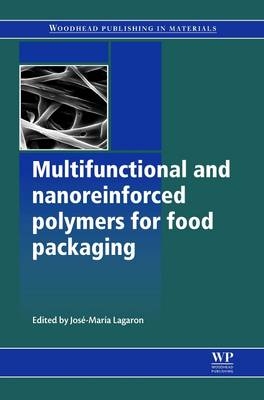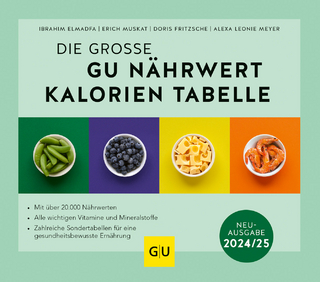
Multifunctional and Nanoreinforced Polymers for Food Packaging
Woodhead Publishing Ltd (Verlag)
978-0-08-101707-4 (ISBN)
After an introductory chapter, Part one discusses nanofillers for plastics in food packaging. Chapters explore the use of passive and active nanoclays and hidrotalcites, cellulose nanofillers and electrospun nanofibers and nanocapsules. Part two investigates high barrier plastics for food packaging. Chapters assess the transport and high barrier properties of food packaging polymers such as ethylene-norbornene copolymers and advanced single-site polyolefins, nylon-MXD6 resins and ethylene-vinyl alcohol copolymers before going on to explore recent advances in various plastic packaging technologies such as modified atmosphere packaging (MAP), nanoscale inorganic coatings and functional barriers against migration. Part three reviews active and bioactive plastics in food packaging. Chapters investigate silver-based antimicrobial polymers, the incorporation of antimicrobial/antioxidant natural extracts into polymeric films, and biaoctive food packaging strategies. Part four examines nanotechnology in sustainable plastics with chapters examining the food packaging applications of polylactic acid (PLA) nanocomposites, polyhydroxyalkanoates (PHAs), starch-based polymers, chitosan and carragenan polysaccharides and protein-based resins for packaging gluten (WG)-based materials. The final chapter presents the safety and regulatory aspects of plastics as food packaging materials.
With its distinguished editor and international team of expert contributors Multifunctional and nanoreinforced polymers for food packaging proves a valuable resource for researchers in packaging in the food industry and polymer scientists interested in multifunctional and nanoreinforced materials.
Professor Jose-Maria Lagarón is group leader and founder of the group Novel Materials and Nanotechnology at the Institute of Agrochemistry and Food Technology (IATA) of the Spanish Council for Scientific Research (CSIC) in Spain. He is renowned for work on the development of eco-sustainable food packaging based on polymer nanomaterials.
Contributor contact details
Preface
Chapter 1: Multifunctional and nanoreinforced polymers for food packaging
Abstract:
1.1 Introduction
1.2 Structural factors governing barrier properties
1.3 Novel polymers and blends
1.4 Nanocomposites
1.5 Future trends
1.7 Appendix: Abbreviations
Part I: Nanofillers for plastics in food packaging
Chapter 2: Multifunctional nanoclays for food contact applications
Abstract:
2.1 Introduction
2.1 Antimicrobial nanoclays
2.3 Oxygen-scavenging nanoclays
2.4 Future trends
Chapter 3: Hydrotalcites in nanobiocomposites
Abstract:
3.1 Introduction
3.2 Hydrotalcite-like compounds (HTlc): basic chemistry
3.3 Organically modified biocompatible hydrotalcite-like compounds (HTlc)
3.4 Nanocomposites of biodegradable polymeric matrices and modified hydrotalcites
3.5 Conclusions and future trends
Chapter 4: Cellulose nanofillers for food packaging
Abstract:
4.1 Introduction
4.2 Morphological and structural characteristics of cellulose nanofillers
4.3 Extraction and refining of cellulose nanofillers
4.4 Mechanical properties of cellulose nanofillers
4.5 Surface modification of cellulose nanofillers
4.6 Preparation of cellulose-reinforced nanocomposites
4.7 Future trends and applications of cellulose nanofillers
Chapter 5: Electrospun nanofibers for food packaging applications
Abstract:
5.1 Electrospinning
5.2 Functional nanofibers
5.3 Nanoencapsulation
5.4 Electrospinning in packaging applications
5.5 Future trends
Part II: High barrier plastics for food packaging
Chapter 6: Mass transport and high barrier properties of food packaging polymers
Abstract:
6.1 Introduction: the basics of mass transport
6.2 Diffusivity
6.3 Solubility
6.4 What makes a barrier a barrier?
6.5 Characterisation techniques
Chapter 7: Ethylene–norbornene copolymers and advanced single-site polyolefins
Abstract:
7.1 Introduction
7.2 Synthesis and molecular structure: advanced single-site polyolefins
7.3 Macromolecular structure: advanced single-site polyolefins
7.4 Macromolecular structure: ethylene-norbornene copolymers
7.5 Nanocomposite preparation: advanced single-site polyolefins
7.6 Future trends
7.7 Sources of further information and advice
Chapter 8: Advances in polymeric materials for modified atmosphere packaging (MAP)
Abstract:
8.1 Introduction
8.2 Modified atmosphere packaging (MAP)
8.3 Physiological factors affecting shelf-life of fresh produce
8.4 Post-harvest pathology of fruits and vegetables
8.5 Response of fresh produce to modified atmosphere packaging
8.6 Polymeric films for application in modified atmosphere packaging (MAP)
8.7 Cellulose-based plastics
8.8 Biodegradable polymers
8.9 Multilayer plastic films
8.10 Gas permeation or gas transmission
8.11 Water vapor permeability
8.12 Packaging systems in modified atmosphere packaging (MAP)
8.13 Advanced technology for efficient modified atmosphere packaging (MAP)
8.14 Package management
8.15 Design of modified atmosphere packaging (MAP)
8.16 Mathematical modeling of gaseous exchange in modified atmosphere packaging (MAP) systems
8.17 Current application of polymeric films for modified atmosphere packaging (MAP) of fruits and vegetables
8.18 Future trends
Chapter 9: Nylon-MXD6 resins for food packaging
Abstract:
9.1 Structure and general overview
9.2 Processing
9.3 Gas barrier properties
9.4 Other properties
9.5 Applications
9.6 Nylon-MXD6 nanocomposites
9.7 Future trends
Chapter 10: Ethylene-vinyl alcohol (EVOH) copolymers
Abstract:
10.1 Introduction
10.2 Structure and general properties of ethylene–vinyl alcohol (EVOH) copolymers
10.3 Ethylene-vinyl alcohol (EVOH) versus aliphatic polyketones
10.4 Processing in packaging
10.5 Improving retorting of ethylene–vinyl alcohol (EVOH)
10.6 Nanocomposites of ethylene-vinyl alcohol (EVOH) and poly(vinyl) alcohol (PVOH)
10.7 Future trends
Chapter 11: High barrier plastics using nanoscale inorganic films
Abstract:
11.1 Introduction
11.2 Nanotechnologies of thin films for advanced food packaging
11.3 Thin film technologies for polymer coating using vacuum processes
11.4 Physical vapour deposition (PVD) processes
11.5 Inorganic thin film systems
11.6 Functional properties of diffusion barrier coated polymers
11.7 Future trends
Chapter 12: Functional barriers against migration for food packaging
Abstract:
12.1 Introduction
12.2 Food safety issues related to migration
12.3 Functional barriers
12.4 Nanostrategies for functional barriers
12.5 Future trends
12.6 Sources of further information and advice
Part III: Active and bioactive plastics
Chapter 13: Silver-based antimicrobial polymers for food packaging
Abstract:
13.1 Introduction
13.2 Incorporation of silver into coatings and polymer matrices
13.3 Antimicrobial silver in food packaging
13.4 Future trends
13.5 Sources of further information and advice
Chapter 14: Incorporation of chemical antimicrobial agents into polymeric films for food packaging
Abstract:
14.1 Introduction
14.2 Antimicrobial agents
14.3 Chemical antimicrobial agents
14.4 Natural antimicrobial agents
14.5 Polymers (synthetic or natural)
14.6 Nano-antimicrobial agents
14.7 Antimicrobial films and coatings
14.8 Antimicrobial activity
14.9 Future trends
14.11 Appendix: Abbreviations
Chapter 15: Natural extracts in plastic food packaging
Abstract:
15.1 Introduction
15.2 Natural plant extracts as antimicrobials and antioxidants
15.3 Designing active plastic packaging systems from natural plant extracts
15.4 Packaging films based on natural extracts
15.5 Factors to consider in designing active systems
15.6 Future trends
Chapter 16: Bioactive food packaging strategies
Abstract:
16.1 Introduction
16.2 Definition and technologies
16.3 Nanotechnologies
16.4 Controlled release of bioactives
16.5 Future trends
Part IV: Nanotechnology in sustainable plastics for food packaging
Chapter 17: Polylactic acid (PLA) nanocomposites for food packaging applications
Abstract:
17.1 Introduction and properties of polylactic acid (PLA)
17.2 Nanobiocomposites of polylactic acid (PLA) for monolayer packaging
17.3 Future trends
Chapter 18: Polyhydroxyalkanoates (PHAs) for food packaging
Abstract:
18.1 Introduction
18.2 Commercial developments
18.3 Polyhydroxyalkanoates (PHAs) and their nanocomposite films
18.4 Polyhydroxyalkanoate (PHA) foams and paper coatings
18.5 Conclusions
18.6 Future trends
18.7 Sources of further information and advice
Chapter 19: Starch-based polymers for food packaging
Abstract:
19.1 Introduction
19.2 Market for starch-based materials and potential applications
19.3 Structure and properties of native and plasticized starch
19.4 Processing in packaging
19.5 Mechanical and barrier performance of starch-based systems
19.6 Nanocomposites
19.7 Future trends
19.8 Sources of further information and advice
Chapter 20: Chitosan polysaccharide in food packaging applications
Abstract:
20.1 Introduction
20.2 Structure and properties
20.3 Processing in packaging
20.4 Antimicrobial chitosan
20.5 Barrier performance
20.6 Nanocomposites
20.7 Future trends
Chapter 21: Carrageenan polysaccharides for food packaging
Abstract:
21.1 Introduction
21.2 Structure and properties of carrageenan
21.3 Processing in packaging
21.4 Barrier performance
21.5 Nanocomposites
Chapter 22: Protein-based resins for food packaging
Abstract:
22.1 Materials (sources, extraction, structure and properties)
22.2 Structure and properties
22.3 Packaging materials characterization (barrier performance, mechanical properties)
22.4 Applications
22.5 Future trends
Chapter 23: Wheat gluten (WG)-based materials for food packaging
Abstract:
23.1 Introduction
23.2 Preparation of wheat gluten-based materials
23.3 Mechanical and barrier properties of wheat gluten-based materials
23.4 Wheat gluten-based nanocomposites
23.5 Example of integrated approach for the packaging of fresh fruits and vegetables
23.6 Future trends
Chapter 24: Safety and regulatory aspects of plastics as food packaging materials
Abstract:
24.1 Introduction
24.2 Indirect food additives
24.3 Nanotechnology in food contact materials
24.4 Migration of additives
24.5 Indian Standards for overall migration (IS:9845-1998)
24.6 US Food and Drug Administration (US FDA) Code of Federal Regulations (CFR)
24.7 European Commission Directives on plastic containers for foods
24.8 Specific migration of toxic additives
24.9 Recent problems in specific migration
24.10 Future trends
24.12 Appendix: Abbreviations
Index
| Erscheinungsdatum | 07.07.2016 |
|---|---|
| Verlagsort | Cambridge |
| Sprache | englisch |
| Maße | 156 x 234 mm |
| Gewicht | 1010 g |
| Themenwelt | Sachbuch/Ratgeber ► Gesundheit / Leben / Psychologie ► Ernährung / Diät / Fasten |
| Technik ► Lebensmitteltechnologie | |
| Technik ► Maschinenbau | |
| ISBN-10 | 0-08-101707-3 / 0081017073 |
| ISBN-13 | 978-0-08-101707-4 / 9780081017074 |
| Zustand | Neuware |
| Haben Sie eine Frage zum Produkt? |
aus dem Bereich


